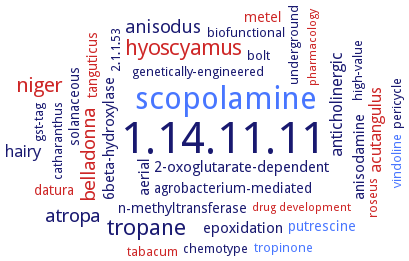1.14.11.11: hyoscyamine (6S)-dioxygenase
This is an abbreviated version!
For detailed information about hyoscyamine (6S)-dioxygenase, go to the full flat file.

Word Map on EC 1.14.11.11 
-
1.14.11.11
-
scopolamine
-
tropane
-
hyoscyamus
-
niger
-
belladonna
-
atropa
-
anisodus
-
anticholinergic
-
hairy
-
acutangulus
-
anisodamine
-
epoxidation
-
2-oxoglutarate-dependent
-
aerial
-
6beta-hydroxylase
-
solanaceous
-
tanguticus
-
agrobacterium-mediated
-
metel
-
putrescine
-
datura
-
n-methyltransferase
-
tabacum
-
chemotype
-
high-value
-
catharanthus
-
pericycle
-
roseus
-
tropinone
-
genetically-engineered
-
biofunctional
-
gst-tag
-
vindoline
-
underground
-
bolt
-
2.1.1.53
-
drug development
-
pharmacology
- 1.14.11.11
- scopolamine
-
tropane
- hyoscyamus
- niger
- belladonna
-
atropa
-
anisodus
-
anticholinergic
-
hairy
- acutangulus
-
anisodamine
-
epoxidation
-
2-oxoglutarate-dependent
-
aerial
-
6beta-hydroxylase
-
solanaceous
- tanguticus
-
agrobacterium-mediated
- metel
- putrescine
- datura
- n-methyltransferase
- tabacum
-
chemotype
-
high-value
-
catharanthus
- pericycle
- roseus
- tropinone
-
genetically-engineered
-
biofunctional
-
gst-tag
- vindoline
-
underground
-
bolt
-
2.1.1.53
- drug development
- pharmacology
Reaction
Synonyms
6H6, AaH6H, AtH6H, Dih6h, H6H, HnH6H, hyoscyamine 6-hydroxylase, hyoscyamine 6beta-hydroxylase, hyoscyamine-6beta-hydroxylase, oxygenase, hyoscyamine 6beta-di-
ECTree
Advanced search results
Application
Application on EC 1.14.11.11 - hyoscyamine (6S)-dioxygenase
Please wait a moment until all data is loaded. This message will disappear when all data is loaded.
analysis
the enzyme is a molecular marker for PCR-based screening approach for tropane alkaloids producing endophytic fungi
drug development
tropane alkaloids, such as hyoscyamine, 6-hydroxyhyoscyamine and scopolamine, are secondary metabolites that are traditionally applied in medicine due to their anticholinergic activity. An alternative strategy for the production of the most valuable alkaloids, 6beta-hydroxyhyoscyamine and scopolamine, using Escherichia coli harboring the hyoscyamine-6beta-hydroxylase enzyme as biocatalysts is developed
pharmacology
tropane alkaloids including hyoscyamine, anisodamine, scopolamine and anisodine, are used medicinally as anticholinergic agents with increasing market demand, improvement of production by metabolic engineering introduction of genes encoding the branch-controlling enzyme tropinone reductase I and the downstream rate-limiting enzyme hyoscyamine-6beta-hydroxylase
synthesis
overexpression of the enzyme (H6H) enhances the biosynthesis of anisodamine and scopolamine in hairy root cultures of Scopolia lurida, which should improve its commercial value. The tropane alkaloids anisodamine and and scopolamine are clinically used as anticholinergic agents


 results (
results ( results (
results ( top
top






